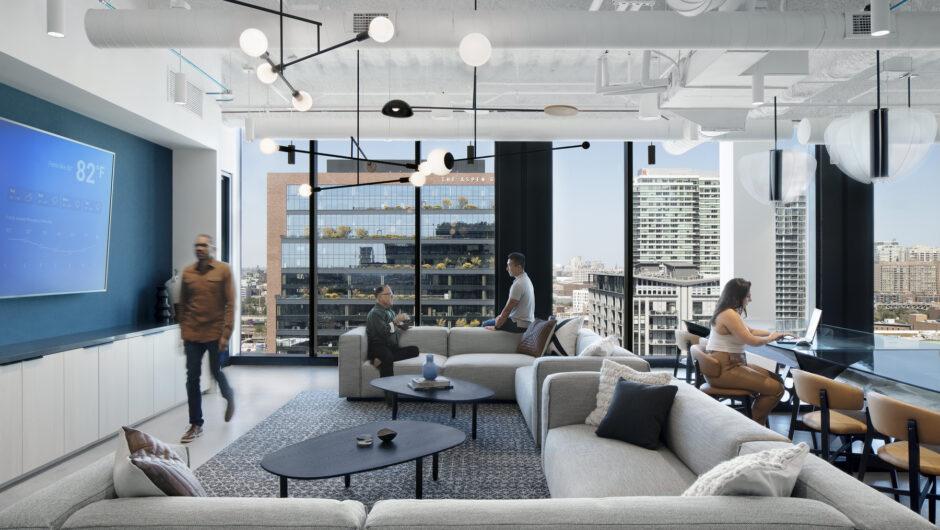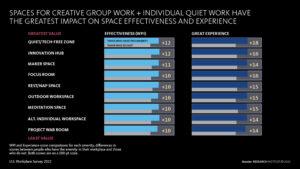Hybrid work has fundamentally shifted how, where, and when we work. It has not only changed the physical workplace, but it’s changed employee and employer expectations about the workplace. The truth is, although the word “hybrid” may be a new term, employees have always been mobile — working both in and out of the office. Hybrid is here to stay, but so is the office. The way we think about the role of the workplace has evolved, and the way we design to support workplaces will continue to evolve for quite some time to come. When coupled with design, space management systems will play a critical role in transforming a better work experience for all.
Transform Your Workplace Experience

Employees Need the Office More Than Ever
In Gensler’s latest U.S. Workplace Survey research conducted late summer 2022, U.S. employees reported that they spend 51% of a typical work week in the office. The balance of the week is spent working in other locations, business travel, coworking sites, third places, and at home. In the survey, we not only asked how much time respondents are currently in the office but also how much time they ideally need to work in their company’s office space to maximize their individual and team productivity. The data revealed a surprising finding — employees report they ideally need to spend more time at the office than they do currently to maximize their productivity! And respondents in the top quartile of the U.S. innovative companies say they need to work in the office 67% of the workweek, which is the exact same percentage we measured before the start of the pandemic in February 2020.
The Workplace Must First Support the Work
In Gensler’s research across 15,000 office workers in six different countries, respondents reported the most important reason to come to the office throughout the pandemic was “working in-person with my team/colleagues.” In our latest global research this summer/fall, “to focus on my work” became the new top reason for people to come to the office. Respondents ranked access to technology, specific spaces, materials, and resources high, as well as scheduled in-person meetings with their team and sitting with their team. There was a shift from working with my team, connecting, and socializing to the broader purpose of simply getting their work done. “Focus on my work” was particularly important for the younger generations.
Gensler has been measuring workspace effectiveness since 2008, and we have seen it change over time. Our recent research shows that workers returning to the office rate the workplace as an effective place for working with others in-person, learning, and socializing; however, space effectiveness for working alone and working with others virtually is at an all-time low. Employees spend the most time working alone; it ranks as critical to job performance, and yet the workplace does not support working alone effectively. “Focus on my work” involves both working alone and with others. Providing a high-performing work environment that minimizes noise, distractions, and interruptions is important to keep people focused on their work and working at their best.

Work Points, Not Desks
As employees first started returning, many companies focused on spaces to bring people together, such as social spaces that spur casual interactions and create community. Food amenities ranging from break rooms to cafeterias are now table stakes and are no longer differentiators. Spaces for individual work, spaces for creative group work, and places to reflect and restore have the greatest impact on workplace effectiveness and experience.
An effective workplace that optimizes productive work no longer just occurs in an assigned desk, workstation, or private office. Approximately 72% of U.S. office workers now report that they have choice where to work within their company’s workplace. “Work points” is the new term encompassing the wide array of work settings that may be provided — ranging from traditional desks to dynamic or touchdown seats to focus or collaboration seats to work cafes.
Work points are designed and equipped based on “dwell time,” ranging from a short duration to half or even full days, with the importance of technology and ergonomic support increasing with dwell time. The quantity of work points is determined by anticipated on-site weekly occupancy with additional ad-hoc seats to support sporadic peak occupancy. Monitoring work patterns to anticipate/predict future occupancy increases in complexity as the work, technology, policies, and employee expectations evolve over time.

Create a Better Work Experience
It’s not enough to provide a new mix of experiences without also creating a better work experience. Leaning on an organization’s workplace management technology can help empower employees and provide a more positive workplace experience. Specifically, within the tech stack, desk reservations and wayfinding help individuals feel more connected to their teammates and more empowered to create their own workplace environment.
With a robust desk reservation and wayfinding tool, such as Wisp, organizations can gain a deeper understanding of the types of experiences their employees are looking for from different work models, neighborhoods, and reservable work points. This also allows for a deeper understanding of work point usage and allows organizations to quickly recalibrate the quantity of work points based on the demand of different spaces as employee work modes evolve. Focusing on an easy-to-use, adaptable tool can enhance collaboration to create a more intentional and efficient experience overall, therefore instilling greater productivity for the time spent in the office and empowering employees to choose their best work experience.
Organizations will undergo continuous experimentation and learning as work evolves and as employees’ expectations change. Design will play a pivotal role in shaping this future workplace — both in terms of the physical space itself and in the systems and technologies for reserving and using the workplace. By coupling space management systems and human-centered design in an integrated, holistic approach, we can create a great work experience where people can thrive.



